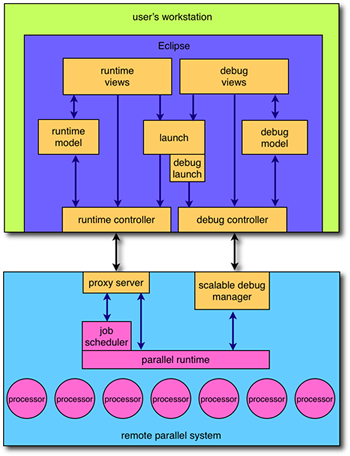Notice: This Wiki is now read only and edits are no longer possible. Please see: https://gitlab.eclipse.org/eclipsefdn/helpdesk/-/wikis/Wiki-shutdown-plan for the plan.
Difference between revisions of "PTP/designs/2.x"
(→Parallel Runtime Environment) |
|||
| Line 12: | Line 12: | ||
To support these requirements, the PTP architecture has been designed as shown in the following diagram. | To support these requirements, the PTP architecture has been designed as shown in the following diagram. | ||
| + | |||
| + | [[Image:ptp20_arch.png]] | ||
=== Runtime Model === | === Runtime Model === | ||
Revision as of 19:58, 14 September 2007
Contents
Overview
The Parallel Tools Platform (PTP) is a portable, scalable, standards-based integrated development environment specifically suited for application development for parallel computer architectures. The PTP combines existing functionality in the Eclipse Platform, the C/C++ Development Tools, and new services specifically designed to interface with parallel computing systems, to enable the development of parallel programs suitable for a range of scientific, engineering and commercial applications.
This document provides a detailed design description of the major elements of the Parallel Tools Platform.
Parallel Runtime Environment
The parallel runtime environment provides an Eclipse-based interface between the user and a parallel computer system. Unlike traditional computer systems, launching a parallel program is a complicated process. Although there is some standardization in the way to write parallel codes (such as MPI), there is little standardization in how to launch, control and interact with a parallel program. To further complicate matters, many parallel systems employ some form of resource allocation system, such as a job scheduler, and in many cases execution of the parallel program must be managed by the resource allocation system, rather than by direct invocation by the user.
In most parallel computing environments, the parallel computer system is remote from the user's location. This necessitates that the parallel runtime environment be able to communicate with the parallel computer system remotely.
To support these requirements, the PTP architecture has been designed as shown in the following diagram.

